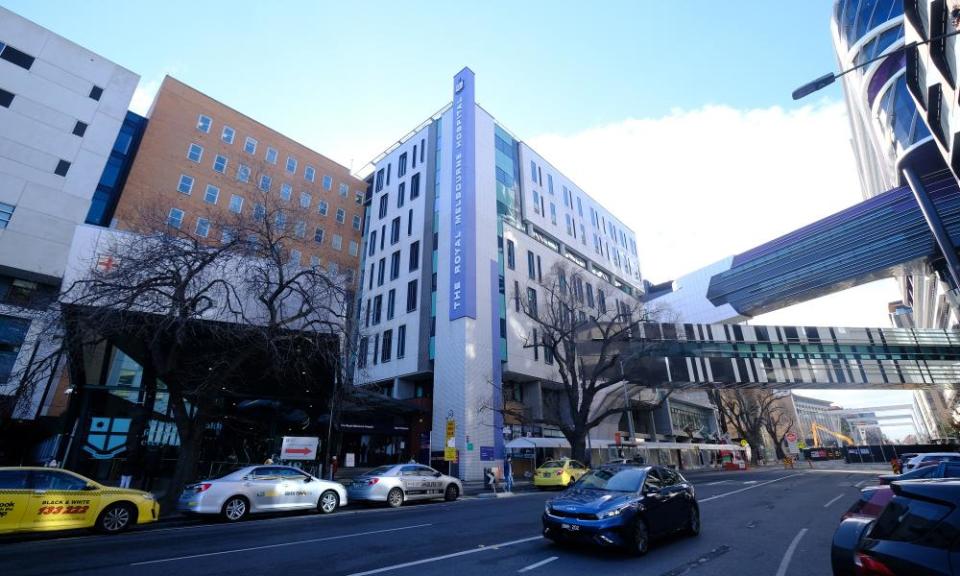Victoria’s hospitals strain under ‘extraordinary’ demand as Covid cases surge

One of Victoria’s largest public hospitals has been forced to close its Covid screening clinic and divert resources to emergency and intensive care patients, as the state’s health system strains under pressure from a surge in cases.
The Royal Melbourne hospital confirmed the closure of its Covid testing clinic on Tuesday. The RMH chief medical officer, Dr Cate Kelly, said the demand on emergency meant the hospital had been forced to close the public clinic. The hospital has four Covid wards, plus the intensive care unit, between them managing 77 Covid-positive patients.
“Over the past two weeks the RMH has without doubt seen an increase in Covid hospital presentations,” Kelly said.
“As a result of this surge, we have had to permanently close our public Covid-19 screening clinic to provide our emergency department with additional capacity to manage the increase in Covid-positive presentations.”
Related: You probably don’t want to have a heart attack or cancer diagnosis in October in NSW, AMA boss says
While authorities on Tuesday were forced to address concerns over 10-minute wait times on triple zero calls, emergency department staff were reported to be taking increased sick leave due to burnout as they struggle with double shifts and increased patient numbers.
A physician working across three Melbourne hospitals, Dr Stephen Parnis, said “pressure on rosters is high”.
“Sick leave is higher than normal, especially for my nursing colleagues, double shifts are much more common,” he said.
The health minister, Martin Foley, said there had been a 55% increase in Covid cases in hospital over the one-week period to Sunday, and the government was discussing plans for boosting hospital capacity. Elective surgery, particularly non-urgent elective surgery, may be paused, he said.
On Tuesday he acknowledged an “extraordinary” demand on the health system.
“And the levels of stress on our healthcare system are only going to increase,” he said.
He said reported 10-minute wait times on triple zero calls was due to increased demand due to rising Covid cases.
The surge in Covid cases in hospital was due to the delay between symptom onset and severe disease developing, Prof Joshua Davis, a clinician and researcher at the Menzies School of Health Research said.
“On average, people who catch Covid and deteriorate to the point of needing hospital admission ... [do so] on day seven to nine after diagnosis, or after onset of illness. And so that’s why the hospitalisations we’d expect to lag by seven to nine days behind diagnosis.”
Parnis said the length of the pandemic and protesters targeting health workers were contributing to staff fatigue and roster gaps.
“We are now more than 18 months into this pandemic with no signs of it abating in the near future,” he said.
“We also do business differently. Even arriving at the hospital is radically different to what it used to be, because I need an extra 10 minutes to sign declaration forms about exposures, to have my temperature checked, to sanitise and get into gowns, masks and gloves. There are times you think twice about even going for a toilet break or getting something to eat because of the time it takes to go through procedures again.
“And then you have staff being told not to wear their scrubs on their way home because they may be targeted by protesters. Some of my colleagues are probably better at ignoring it than I am, but when these protests happen in the community with people persecuting those providing vaccination … it just cut through the layers, I have to say.”
According to Burnet Institute modelling provided to the Victorian government, even without any easing of restrictions, there is a moderate risk of exceeding health system capacity. According to the modelling, a peak in seven-day average daily diagnoses of 1,400-2,900 cases is estimated to occur between 19 and 31 October. This would result in corresponding peaks in hospital and intensive care demand, with 24% of model simulations resulting in hospital demand exceeding 2,500 beds.
“I think we’re as prepared as we can be,” Parnis said. “Is that a guarantee that we’ll get through this unscathed? Absolutely not.”
Email: sign up for our daily morning briefing newsletter
App: download the free app and never miss the biggest stories, or get our weekend edition for a curated selection of the week's best stories
Social: follow us on YouTube, Facebook, Instagram, Twitter or TikTok
Podcast: listen to our daily episodes on Apple Podcasts, Spotify or search "Full Story" in your favourite app
A Victorian department of health spokesperson told Guardian Australia that hospitals had been preparing for the coronavirus pandemic since last year, creating extra capacity and ensuring there were enough beds, equipment, PPE and staff to manage any surge in patients, while maintaining other services.
The Northern hospital in Epping was taking a significant proportion of the state’s Covid-19 cases, with more than half of the 867 Covid-19 cases announced on Tuesday in the northern suburbs.
The Northern hospital had three dedicated Covid wards, as well as a section for Covid patients in intensive care.
Video taken outside the hospital on Monday showed more than a dozen ambulances outside the hospital “ramping” – a term used when patients were left in ambulances waiting to be admitted because the emergency department was full.
The chief operating officer for Northern Health, Debra Bourne, said Monday was particularly busy for emergency, with 96 ambulance arrivals and 403 patients seen.
“We need to carefully screen patients for Covid-19, which means it is taking longer for us to receive patients into the emergency department,” she said. “These are unprecedented times.”
About 65 Covid-19 patients were in the Northern hospital. As of Tuesday there were 375 people in hospital with the virus throughout Victoria. Of those, 81 were in intensive care, and 61 on a ventilator.

 Yahoo Finance
Yahoo Finance 